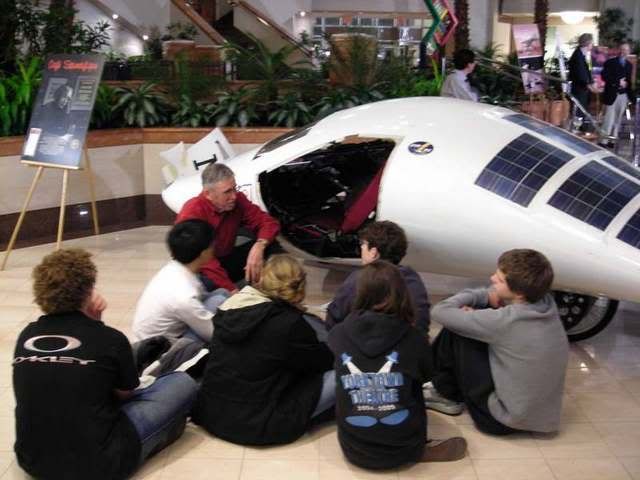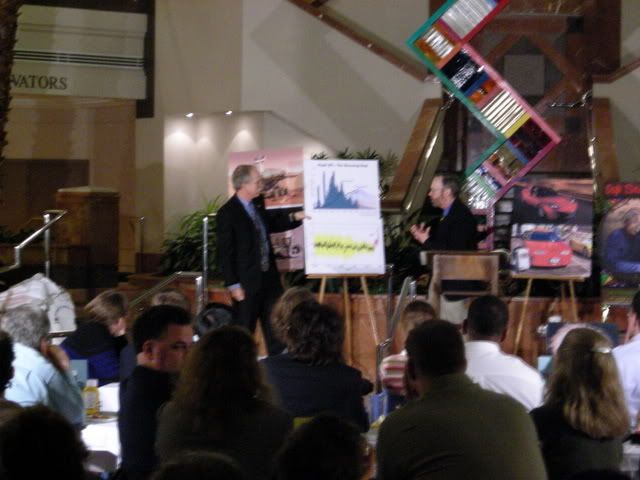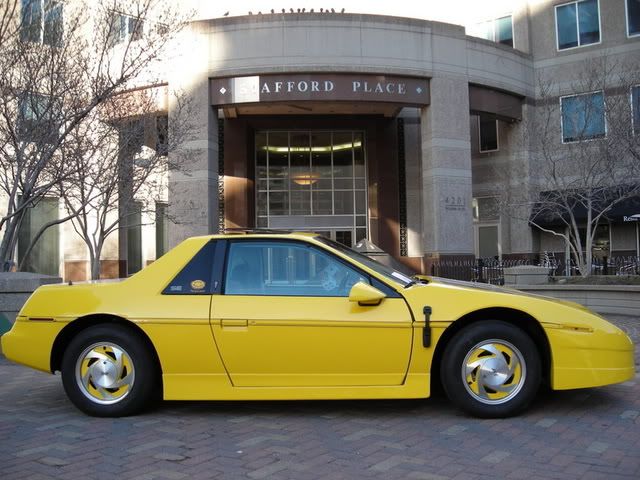
The local weatherman said the day was going to be cold and windy. He warned of a nor’easter on its way, but the tenacious EVers from the EVA/DC were undeterred. This was a rare opportunity. This was a special occasion indeed. The National Science Foundation sponsors an informal gathering at its headquarters to bring the lofty air of its work to a comfortable more accessible venue. And what could be more comfortable than a Café? A Café Scientifique it is. The National Science Foundation’s Café Scientifique is held on the first Tuesday of every month. It is a place to gather around eat a little, drink a little and talk about science. This past March 6th the Café Scientifique dedicated itself to, “The Shocking Science Behind Electric Cars.” And EVA/DC and its leadership were the speakers. 
The main stage was to be the domain for the President and Vice-President of the Electric Vehicle Association of Washington, DC Dave Goldstein and Charlie Garlow. The two intrepid electric vehicle experts put on a classe de comidy. One audience member said that listening to them was like listening to Click and Clack, the Tappet Brothers of National Public Radio fame, only for electric vehicles. However, the message was much more serious then their comedic demeanor suggested. The message was clear that electric vehicle technology had advanced to such a state that just a little push and some funding would tip the scales to a commercially viable electric vehicle. The presentation was lively and the audience showed enthusiasm for the subject with the keenness of their deep probing questions. With every answer the audience’s eagerness for the plug-in option manifested itself with a audible responses and clapping. At one moment during the presentation, Mary Hanson, the master of ceremony for the event asked the audience. “How many of you would purchase an electric car if one were available today?” Nearly every hand in the audience rose.
The other star of the show was the solar cell clad commuter vehicle from MIT named AZTEC. Rescued from its certain destination, a New England landfill, the enthusiasts of the Electric Vehicle Association of Washington, DC painstakingly took weekends and holidays for nearly three years to resurrect the vehicle from what had literally been buckets of parts. The vehicle must have felt the change in its stature, from having been turned into scrap in the corner of an advanced automotive lab at MIT to this day’s proceedings, where it assumed its place of honor. This day the AZTEC was allowed to park its wheels on the polished marble in the very temple of science, the National Science Foundation’s atrium. The AZTEC was born to push the boundaries of science and engineering and fulfilled its promise by winning in multiple categories at the American Tour de Sol back in 1994. At the NSF it shined like a brilliant and precious stone whose sparkle was the very luminescence of knowledge from a bygone day. There it was surrounded by those who would be the next generation of seekers. These new seekers looked upon that AZTEC with the respect that should be given an elder. They listened as its assigned oracle, a man by the name of John Clinton, told them about the history of the vehicle and its many accomplishments. He told them of the rescue, and the importance of learning its many truths. He told them these things so they would bring them forward, so that others in the present may know of what is possible with the flicker and the spark of electricity.

Outside on the sidewalk, waiting for the dreadful cold wind that never showed up, the other EVA/DC members who had brought electric vehicles for people to see and touch were standing aside their machines prepared to answer all usual questions typically asked. Questions like, how far can it go on a charge? How much gas does it use? Where can I get one? And, can I touch it? Unlike the lofty prototypes and show cars displayed at auto shows where the public isn’t allowed to get an intimate look, there would be no separating these stars from tactile access by their audience. These weren’t the prima donnas of stage, these were practical every day vehicles, though a rare sight on main street USA.
Joseph Lado, an employee of NSF and one of the organizers of the event, arrived early in the day with his sports car he named EV SOL. The EV SOL is a Pontiac Fiero converted by Solar Electric Engineering back in 1993. The vehicle that Dave Goldstein refers to as “Joe’s bright yellow zonker” took its place by the pyramid fountain in front of NSF. With its hood and trunk covered with solar panels and its sporty look, the car never fails to draw a crowd, and it didn’t disappoint this day either.
Next to the show was Mike Harvey with his VW Cabriolet. Sometimes called the “energizer” other times called the “Cabby” the EV is a terrific example of what can be done with an EV with off the shelf components, and what he can build for anyone. Stunningly beautiful inside and out, the vehicle leaves no doubt why it was the Battery Beach Burnout’s Show-N-Shine contest winner. (http://www.harveyev.com/)
Then Fairfax County, Virginia lent a hand to the proceedings by bringing its plug-in Toyota Prius, driven there by its care taker David Duval. The Prius represented the near future of electric propulsion for vehicles. This vehicle uses a Lithium-ion battery pack to get 40 miles on electricity that comes from an ordinary household plug, before returning to its standard hybrid mode. The Prius conversion kit and installation was provided to Fairfax County by Hymotion of Toronto, Canada. (http://www.deq.virginia.gov/p2/vise/fairfaxcar.html)
Bryan Murtha brought his RAV4 EV, a vehicle the represents the most practical application of an electric vehicle to date. Built in the late 1990s to comply with California’s Zero Emission Mandate, the vehicles have proven the reliability of the Nickel Metal Hydride batteries they use with many of the built vehicles going well over 100,000 miles on their original pack.
Jay Grossman brought his Solectria, Force.
All in all, it was a night to remember. Six electric vehicles gracing the doorways and the inner sanctum of an institution that distributes over 4 billion dollars in grant money for research. We all hope that what we did in bringing electric vehicles to the NSF had a little influence on those inside those hallowed halls to look more favorably on the science behind electric vehicles whether shocking or not.



Great report, Joe. Wish I could have been there.
Thinking over what is keeping the auto companies from moving forward with electric cars – recently, a friend told me of her relative, an auto company legal department executive, who had a new electric car at home to test drive, so it’s not that they DON’T exist – it occurs to me that politics and vested interests are controlling the matter.
A nationwide shopping boycott is planned for April 15-22, with the intent to use economic pressure to help end the war in Iraq. Among the links at the website is the 2006 Fortune 500 listed by revenue. Oil companies rank high: Exxon Mobil #1, Chevron #4, Conoco Phillips #6 and Marathon Oil #23. Although GM ranks #3 in revenues, it is losing money, and Ford at #5 has less profits than any of the oil companies I named.
A second listing, donations to political parties, is worth considering. Although a number of unions and associations lead the list with, for example, the UAW # 14, donating $23 million and the Teamsters #12 donating $24 million, both designated as over 90% going to support Democrats.
Then, along come GM donating $9 million, 60-69% to Republicans; Chevron donating $9.4 million, 70-89% to Republicans, and Exxon Mobil donating $9 million, also 70-89%, with over 90% in one year, again to Republicans.
What I take away from such numbers is that the big oil companies are intent on maintaining the status quo. To give them credit, GE #7 in revenue, led the way to forming the US Climate Action Partnership with other forward-looking companies and organizations.
We can hope that Wednesday’s Environment Committee hearing that Sen Boxer is holding, with Al Gore testifying, will focus attention on solutions such as electric cars.
The political donation figures reported are cumulative totals from 1989-2006.